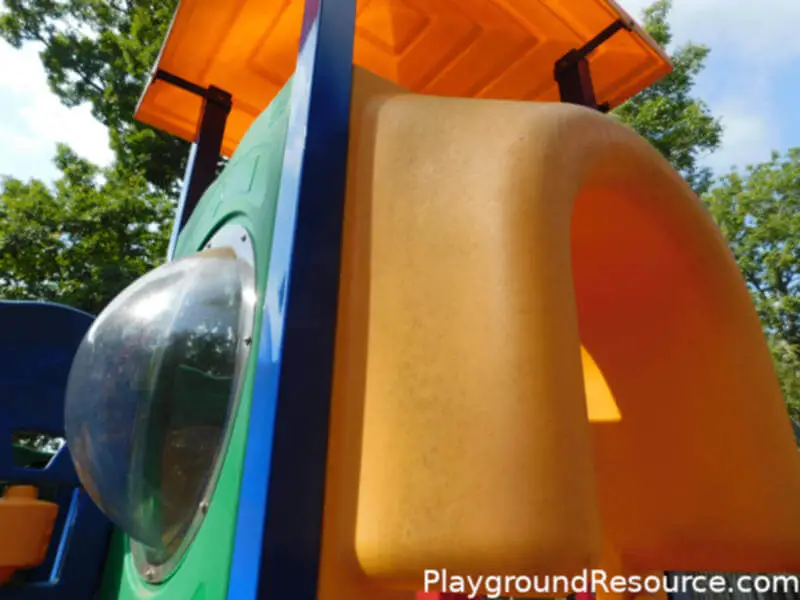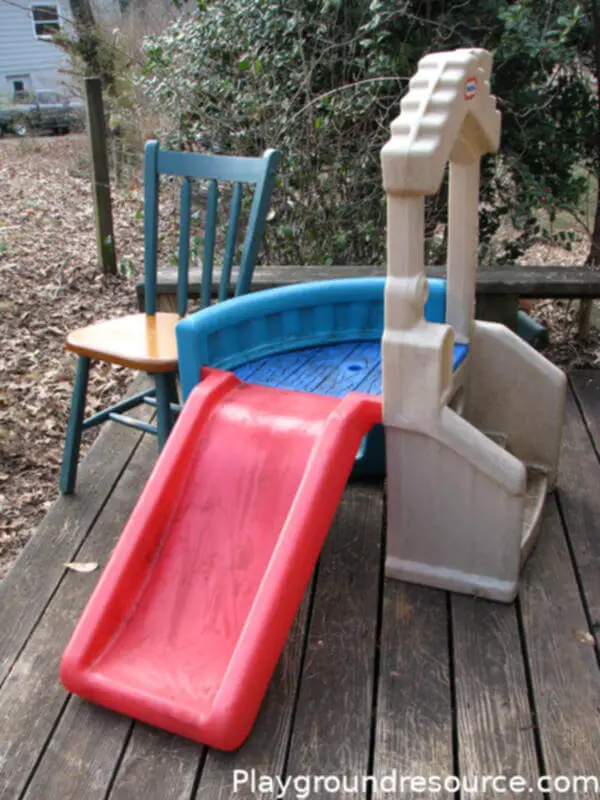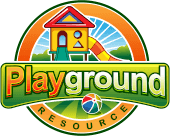
Do you have dirty, moldy, mildewy and stained plastic playground equipment or toys? Then, this article is for you.
Hold it! There’s no need to go out and buy new equipment just yet.
The great thing about plastic is its durability. While it may not look like it did when it was brand new, I’ll show you some proven and effective methods to make it look new again.
Whether its mold, mildew, scuff marks and dirt, I have the solution. Your plastic playground equipment and toys are not beyond hope – you can bring them back to life with these proven methods.
Table of Contents
Step One – Washing the Plastic
No matter the condition of your plastic playground gear, if it’s dirty, then this is where you should start. If any stains remain just follow the next steps.
This is also a great routine to get into, do this once a month or so during “peak play season” to keep your equipment from getting stained and to keep it sanitized. Get the kids involved and make it fun!
Here are the items that you’ll need:
- Pail or bucket
- Clean rag (mop for bigger areas)
- Scrub brush
- Water hose or an extra bucket for rinsing
- Liquid dish soap
- White distilled vinegar (optional)
Steps:
1. Rinse the plastic toys or equipment that you want to clean with a water hose or bucket of clean water.
2. Put about 2 tablespoons of liquid dish soap into the bucket then fill with water, creating a nice foamy bucket of soapy water.
Tip – Mix in 1 cup of White Distilled Vinegar to the bucket if you have mold or mildew. White Vinegar will kill bacteria, and fungus and has been proven to kill 82% of all mold species.
3. Now, soak the rag or mop in the soapy water and wipe on the surface of the item you’re cleaning- really soak it down, like you’re washing a car.
4. Take your scrub brush, and using circular and up and down motions on the plastic, start to scrub. The dirt and grime will lift right off
5. Rinse – be sure to have your water hose or a bucket of fresh water close by to rinse the dirt off. For larger items, rinsing as you go is recommended.
This is a natural, simple and effective way to clean your plastic playground gear and toys. If your equipment is older, and has dirt and/or mildew and mold stains that this will not remove, check out the next steps.
Step Two – Removing Stains and Spot Cleaning
If you have any remaining stains such as dirt, mold or mildew, this method should not only remove them but will also sanitize your plastic equipment and toys.
Bleach and vinegar are very effective in the removal of mold and mildew from any surface.
Bleach and Water Method
The usual solution is made up of one cup bleach to one gallon of water or 1 part bleach to 10 parts water.
Here is what you’ll need:
- Gloves
- Bucket (Spray bottle for smaller areas and spot cleaning)
- Bleach (Chlorine)
- Scrub brush
Take care in using bleach. If inhaled, it can damage the lungs. Also be sure not to splash on the skin or clothes.
Steps:
1. Add 1 cup of bleach to 1 gallon of water in a bucket. Or 1 part bleach per 10 parts water in a spray bottle.
2. Soak the plastic toys or equipment in the bleach and water solution using a rag (wear gloves!) or the spray bottle. Let the solution sit for a minute or two.
3. Scrub the plastic vigorously using a scrub brush until the stains lift.
4. Rinse with water to completely remove the bleach formula. Be sure not to spray the water too hard as you rinse, to prevent the bleach from splashing back onto you.
5. Air dry for around 30 minutes until fully dry.
Vinegar and Water Method
White vinegar is an effective disinfectant and safer, natural cleaning alternative to bleach. The use of white vinegar will effectively remove dirt, mold and mildew stains on your kid’s plastic toys.
The usual solution is 1 part white distilled vinegar to 1 part water.
You will need these items:
- White distilled vinegar
- Essential oil (optional)
- Bucket (Spray bottle for smaller areas and spot cleaning)
- Scrub brush
- Water
- Gloves (optional)
Steps:
1. Mix equal parts water and white vinegar in a bucket or spray bottle.
Tip – Add your favorite essential oil the the mix to neutralize the strong vinegar odor and create a pleasant smelling solution.
2. Generously soak the plastic down with the solution using a rag or spray bottle and let sit for 5 minutes (you may have to add more during this time to keep the plastic wet).
3. Scrub vigorously using a scrub brush or heavy-duty sponge.
4. Rinse completely with clean water and let dry.
Step Three – Scuff Marks and Ground in Dirt
If you still have remaining stains that seem immovable, they are probably the result of “ground in” dirt and scuff marks. Here are some inexpensive solutions that you can use to remove these tough stains.
Sandpaper Method
Sanding is ideal for cleaning and polishing plastics. It will remove any scuff marks along with the ground in dirt. All you need is fine-grit sandpaper. Any sandpaper from 320 – 600 grit will do.
You may want to opt for wet sanding, which tends to show the best results on plastic without leaving being unsightly scratches. Just dip the sandpaper in water before you sand, and/or spray the plastic with water as you go.
What you’ll need:
- Sandpaper 320 – 500 grit (The lower the grit the more course the sandpaper is)
- Water
- Rag or paper towels
Steps:
1. Make sure the surface of the plastic is clean.
2. Wet the sandpaper. You can just dip it in water or wet it with a water hose.
3. Rub the plastic surface vigorously with the sandpaper using fast and short motions. Focus on only a small area at a time. Do this until the scuff and stain are completely removed and you have a smooth surface.
Tip – For the best results start with a lower grit (courser) sandpaper and finish with a higher grit. For example, you can start with a 320 grit then “polish” the plastic extra smooth with a 500 or 600 grit.
4. Wipe clean with a wet rag or paper towel.
Magic Eraser Method
I’m sure you’ve heard of the cleaning product Mr. Clean Magic Eraser. This product is made of a cured foam material called melamine. It basically cleans surfaces by acting as super-fine grit sandpaper.
So if you don’t want to deal with sandpaper, and/or already have some of these in your home, then this method will also work.
What you’ll need:
- Magic Eraser cleaning product
- Rag or paper towels
- Water
Steps:
1. Make sure the plastic is clean using one of the methods above.
2. Scrub the plastic surface with the magic eraser vigorously, using fast and short motions. Try wetting the eraser and plastic for better results.
3. Wipe clean with a wet rag or paper towel.
When You Should Consider Painting Your Plastic Playground Equipment
There is no safe and effective method to restore weather faded plastic. There are some products that claim to restore the color of plastic, but from experience, I can tell you that they do not “stay restored” for very long and take a long time to apply.
Also, a lot of these products aren’t safe for children, who have a tendency to put their mouth’s on their toys.
Plastic toys and equipment are a smart buy, because plastic is so durable and will last for many years, but permanent fading will occur- especially on outdoor equipment.
If your plastic playground equipment and/or toys are still structurally sound but look terrible, an affordable and easy solution is to paint them.
At a fraction of the cost compared to buying new equipment you can give another life to these playground favorites. Please read our article titled “How to Paint Plastic Playground Equipment – Fully Restore” (opens in new tab) for a step-by-step guide on how to do this.
Dangers of Dirty Playground Equipment

Dirty playground equipment can pose some serious health problems. Mold, mildew, and bacteria can cause serious illnesses and worse.
Keeping your play equipment clean is essential to providing a healthy play environment for children. Once you have your playground equipment and toys clean, it’s easy to maintain them and keep them clean.
Mold and Mildew
There are dangers associated with having mold and mildew on playground equipment and children’s toys. Exposure to molds heightens the risks of health issues like allergies, asthma and continuing sinus infections.
Allergies are not seasonal, these can occur at any time of the year. Molds can contain contaminants that affect the central nervous system and immune system thereby compromising vital brain and body functions.
People exposed to mildew have the possibility to acquire fungal infections in their lungs along with other potentially serious health hazards.
Symptoms of mildew exposure can consist of respiratory problems, headaches; irritation of the eye, throat or nose; nasal congestion; and gasping for breath.
Final Thoughts and Considerations
Plastic playground equipment and toys are durable, safe, and last a long time. When their appearance starts to deteriorate, you can remedy this and restore them without having to purchase new and expensive equipment.
A great way to save money is buying used play equipment and toys and restoring them yourself.
I hope this article has been helpful, remember to be safe and have fun!

Kathryn
Over 14 years in special education with a BA in psychology. I work daily with children of all kinds, with a special focus on childhood development and play using music and play equipment among other tools.
